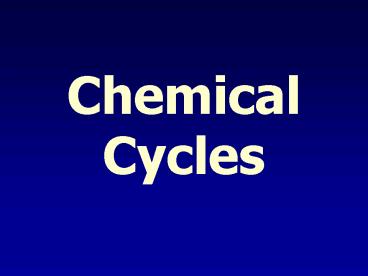Chemical Cycles - PowerPoint PPT Presentation
1 / 38
Title:
Chemical Cycles
Description:
TECTONIC: Creation and destruction of earth's crust. ROCK: Produces rocks and soils ... Cycling of water through soil, atmosphere, surface waters, ice caps, ... – PowerPoint PPT presentation
Number of Views:20
Avg rating:3.0/5.0
Title: Chemical Cycles
1
Chemical Cycles
2
Outline
3
Major cycles
TECTONIC Creation and destruction of earth's
crust
ROCK Produces rocks and soils
HYDROLOGIC Cycling of water
BIOGEOCHEMICAL Cycling of chemical elements
4
Hydrologic cycle
DEFINITION Cycling of water through soil,
atmosphere, surface waters, ice caps, glaciers
WATER Exists as liquid, solid, or vapor
5
Atmosphere (0.001)
Lakes (0.009)
Rivers (0.001)
Oceans (97.2)
Shallow Groundwater (0.03)
Hydrologic (Water) Cycle
6
Land Precipitation
Evaporation and Transpiration
Ocean Precipitation
Ocean Evaporation
Hydrologic (Water) Cycle
7
Biogeochemical cycles
DEFINITION Cycling of chemical elements
8
What is an element?
Table 4.1
9
Atoms
Comprised of protons, neutrons, and electrons
Protons and neutrons are about 1000 times more
massive than electrons
Protons positively charge, electrons negatively
charged, and neutrons neutrally charged What
does this mean?
10
Where do elements come from?
SUPERNOVA Exploding stars Elements other than
H formed in stars Scattered when star
explodes Condense into planets Cycle within
planet (closed system)
11
Elements cycling
Elements can form different compounds while
cycling
N2 (nitrogen gas)
NO3- (nitrate)
NH3 (ammonia)
12
An example of cycling - carbon
13
General cycle characteristics
Reservoir B
Reservoir A
Flux A ? B
Flux B ? A
FLUX RATE amount entering or leaving a reservoir
per unit time (high flux rate rapid cycling)
RESIDENCE TIME length of time material stays in
reservoir (short residence time rapid cycling)
14
Rates of cycling
15
Biogeochemical cycles
Cycling of materials through
16
Why study them?
Human activities can affect the cycling of
materials
17
What cycles are important?
Macronutrients
Elements needed in large quantities by living
things Ex. carbon, nitrogen, hydrogen, oxygen,
phosphorous
Micronutrients
Elements needed in small quantities by living
things Ex. copper, zinc
18
Cycling within ecosystems
Cycling usually examined within ecosystems
african savanna
1 m2 of topsoil
Examples
lake
a puddle of water
19
Cycling overview
20
Biota and cycling
21
Ignore units, focus on relative values
Atmosphere (720 3 per yr)
Soils (1500)
Land plants (560)
Shallow ocean (39,000)
Fossil fuels (4000)
Sedimentary rocks (100,000,000)
Carbon Storage
22
Volcanoes (0.1 per yr)
Burning fossil fuels (5.4 per yr)
Land photosynthesis and respiration (120 per yr)
Ocean photosynthesis and respiration (107 per
yr)
Carbon Cycle
23
Carbon Cycle in a lake
24
Nitrogen cycle
Atmosphere (4,000,000,000)
Land plants (3,500)
Most organisms can't use nitrogen gas directly -
it must first be "fixed" into a solid form by
bacteria
Organic soils (9,500)
25
Nitrogen fixation (bacteria)
26
Nitrogen Fixation and Denitrification rates
Land Fixation (140 per yr)
Ocean Fixation (30 per yr)
Industrial Fixation (100 per yr)
Land denitrification (130 per yr)
Ocean denitrification (110 per yr)
27
Phosphorous Cycle
Phosphorous has no gaseous phase it is a
limiting nutrient because of this (does not
cycle quickly)
Cycle has been greatly enhanced by mankind
28
Sulfur Cycle
Necessary for some amino acids and sulfate esters
Naturally gets into the cycle by plants absorbing
it through the soil
Mankind has greatly enhanced this cycle by
burning sulfur-bearing coal
29
Human effects on cycles
30
Human impacts on cycling
31
Water Human impacts
Transpiration (water release from photosynthesis)
by vegetation forms clouds
Tropical forests cleared
Tropical deforestation forests cleared less
transpiration water cycle affected
32
Water Human impacts (?) Global temperature
increases
33
Carbon Human impacts (?) Global warming
Burning fossil fuels more CO2 in
atmosphere note small contribution compared to
other cycle components may be sufficient to
alter carbon cycle
34
Carbon Human impacts
Deforestation burning adds CO2 to
atmosphere less vegetation to take up CO2 uptake
from atmosphere carbon cycle disrupted
35
Nitrogen Human impacts Industrial fixation
Fertilizers nitrogen historically
limiting industrial fixing - late 1800's allows
large-scale farming
Effects overwhelms denitrification
rates eutrophies waterways rapid population growth
36
Feedback
Output from a system acts as input in order to
change the system
Ex. Microphone near the speaker
37
Negative Feedback
Change that drives the system back to equilibrium
- Humans increase the amount of carbon dioxide in
the atmosphereby burning fossil fuels. - Increased carbon dioxide causes increase in plant
life - More plants means more carbon dioxide absorbed -gt
lesscarbon dioxide in the air
38
Positive Feedback
Change that drives a system away from equilibrium
- Humans increase the amount of carbon dioxide in
the atmosphereby burning fossil fuels. - Increased carbon dioxide causes atmospheric
temperature increase - Higher temperatures means oceans less able to
hold carbondioxide -gt more carbon dioxide in the
air































